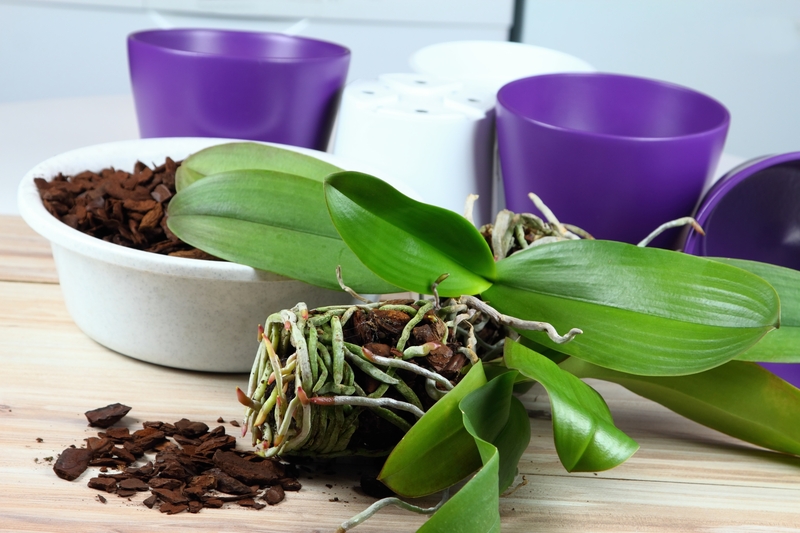Elevate Your Green Thumb with Orchids
Posted on 17/05/2025
Elevate Your Green Thumb with Orchids: The Ultimate Guide
Are you dreaming of taking your gardening skills to extraordinary heights? If so, orchids are the ultimate companion to elevate your green thumb. Renowned for their exquisite blooms and rich diversity, these fascinating plants have enchanted garden enthusiasts and botanists for centuries. Whether you're a curious beginner or a seasoned plant aficionado, discovering how to grow and care for orchids can expand your horticultural expertise and beautify your indoor garden spaces.
Why Orchids? The Allure of Exotic Elegance
Orchids bring a sophisticated charm unmatched by many other houseplants. Their delicate flowers and intricate patterns make them prized possessions among plant lovers globally. But what truly sets these stunning blooms apart? Here are some reasons why cultivating orchids can elevate your green thumb and enhance your gardening experience:
- Diversity: With over 25,000 species and 100,000 hybrids, orchids offer endless variety in color, shape, and fragrance.
- Longevity: Many orchid blooms last for weeks or even months, providing lasting beauty.
- Resilience: Contrary to their reputation, a well-cared-for orchid can be robust and adaptable to different environments.
- Air Quality: Like other houseplants, orchids contribute to indoor air purification, making your home healthier.
- Therapeutic Hobby: Growing orchids is a rewarding journey that promotes mindfulness and relaxation.

Understanding Orchids: A Brief Botanical Overview
Orchids belong to one of the largest and most diverse plant families in the world: Orchidaceae. Their adaptability has allowed them to flourish in almost every habitat on earth, from tropical rainforests to arid deserts. However, the most common orchids for home cultivation are epiphytic varieties, which naturally grow on tree branches, extracting moisture and nutrients from the air.
Popular Varieties to Grow at Home
- Phalaenopsis (Moth Orchid): Ideal for beginners, these orchids boast long-lasting, colorful flowers and thrive in moderate indoor conditions.
- Cattleya: Known for their vibrant hues and striking fragrances, perfect for those eager to take on more advanced care.
- Dendrobium: With their delicate clusters and resilience, dendrobiums are suited to varying environments and make an eye-catching display.
- Oncidium (Dancing Lady): Lively sprays of yellow or pink flowers give these orchids their signature movement and charm.
- Vanda: Celebrated for their striking blues and purples, requiring high humidity and bright light.
Essential Orchid Care Tips for the Aspiring Green Thumb
If you want to elevate your gardening skills with orchids, understanding their unique needs is fundamental. Although orchids may be seen as delicate, proper care can ensure your plants flourish for years. Here's what you need to know:
1. Choosing the Right Orchid
Select an orchid species that aligns with your living conditions and experience level. Phalaenopsis is an excellent starter choice due to its adaptability, while Cattleya and Vanda might suit you once you've mastered the basics.
2. The Importance of Light
- Indirect sunlight: Most orchids prefer bright but filtered light. Direct sun can cause leaf burns.
- North- or east-facing windows are usually ideal for indoor orchids.
- If natural light is insufficient, consider supplemental grow lights.
3. Watering Techniques
Overwatering is the most common cause of orchid troubles. Generally, water when the potting mix feels dry an inch below the surface.
- Use room-temperature, distilled, or rainwater for the healthiest plants.
- Water thoroughly, allowing excess moisture to drain away.
- Do not let orchids sit in standing water, as this can cause root rot.
4. Potting & Medium
- Choose breathable containers: Orchids do best in pots with drainage holes and excellent air circulation.
- The best potting media includes bark, sphagnum moss, perlite, or a specialized orchid mix.
- Repot every 1-2 years to refresh the medium and check root health.
5. Humidity and Air Circulation
Orchids thrive in humid environments--ideally around 50%-70%. Use these tips to maintain ideal conditions:
- Place a humidity tray filled with pebbles and water beneath the pot.
- Use a room humidifier during dry months.
- Ensure adequate air movement with fans or by opening windows occasionally.
6. Feeding and Fertilizing
- Feed orchids with a balanced, diluted orchid fertilizer every 2-4 weeks during active growth.
- In winter, reduce feeding as growth slows down.
7. Pruning and Grooming Tips
- Remove dead or yellowing leaves to promote airflow and focus energy on healthy growth.
- After blooms fade, trim flower spikes just above a node to encourage future blossoming.
Common Orchid Problems and Solutions
Even the most experienced gardeners encounter hiccups. Here's how to troubleshoot common orchid issues and elevate your green thumb skills:
- Yellowing leaves: Often a sign of overwatering or lack of nutrients. Solution: Check root condition and adjust watering or fertilizing schedule.
- Root rot: Soft, black, or mushy roots due to excess moisture. Solution: Repot in fresh medium and cut off affected roots.
- No blooms: Could be insufficient light or improper feeding. Solution: Increase light exposure and use bloom-boosting fertilizers.
- Pest infestations: Watch for mealybugs, spider mites, or scale. Solution: Use neem oil, gentle soap spray, or rinse plants carefully.
Orchid Propagation: Multiply Your Collection
Once your confidence grows, why not multiply your orchid collection? Orchid propagation offers both a rewarding challenge and a deeper connection with your plants. The most popular methods include:
- Division: Gently split mature orchids with multiple growths into separate pots during repotting season.
- Keiki propagation: Some orchids, like Phalaenopsis or Dendrobium, form baby plants (keikis) along their stems. Once they develop roots, carefully detach and pot them.
- Back bulb propagation: Older, leafless pseudobulbs can sometimes produce new growth when potted separately in moist sphagnum.
Decorative Ideas: Orchids as Living Art
Beyond their horticultural appeal, orchids can elevate your home decor with their sculptural beauty. Here are creative ideas for integrating orchids into your living spaces:
Statement Orchid Arrangements
- Combine different orchid species in a decorative planter for a vibrant centerpiece.
- Use glass vases or terrariums to showcase orchid roots and encourage humidity.
- Mount epiphytic orchids on driftwood for a natural, artistic focal point.
Functional Placement Tips
- Brighten up bathrooms where natural humidity matches orchid needs.
- Display on mantels, side tables, or hanging installations for visual interest.
- Create an indoor "orchid wall" by mounting multiple miniatures on a vertical frame.
Expert Advice: Success Secrets for Thriving Orchids
Ready to become an orchid-growing expert? Follow these advanced tips to truly elevate your green thumb with orchids:
- Monitor microclimates: Subtle changes in temperature, humidity, and airflow affect orchids. Track these with apps or sensors to adjust care as needed.
- Inspect roots regularly: Healthy orchid roots are firm and green or silvery-white. Check roots visually during watering and when repotting.
- Be patient: Many orchids need a rest period after blooming; resist the urge to over-fertilize during dormancy.
- Rotate plants: Turn pots every week so each side receives equal light, promoting even growth and flower production.
FAQs: Answering Common Orchid Questions
- How often should I water my orchid? Water every 7-10 days or when the top inch of the potting mix is dry. Adjust frequency for climate and season.
- Why aren't my orchids blooming? Lack of light, incorrect feeding, or insufficient rest can cause bloom failure. Adjust care and be patient.
- Can orchids grow in any soil? No--orchids require a special airy medium such as bark or sphagnum, not regular potting soil.
- Are orchids toxic to pets? Most orchids are non-toxic, but always verify the safety of your chosen variety.

Start Your Orchid Journey Today
Elevating your green thumb with orchids is a satisfying and enriching endeavor that offers more than mere aesthetics. Orchids nurture patience, observation, and a deeper appreciation for the wonders of nature. By mastering their care, exploring their diversity, and getting creative with design, you can transform your home and your gardening skills.
Don't be intimidated by tales of their delicacy--orchids are resilient companions ready to thrive with your attention and affection. Choose your favorite species, create the perfect environment, and soon you'll be rewarded with stunning blooms and a vibrant, elevated green thumb!
Further Resources and Continuing Your Orchid Education
- American Orchid Society: Expert articles, care sheets, and community advice
- Royal Horticultural Society - Orchids: Guidance on varieties and display
- Wikipedia: Orchidaceae: Explore the vast family of orchids
Elevate your green thumb with orchids--start your journey today and unlock a world of color, creativity, and gardening mastery!

